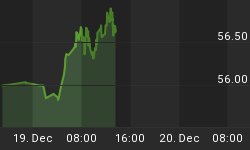Based on the June 7th, 2012 Premium Update. Visit our archives for more gold & silver analysis.
Remember the disaster movie, "The Day After Tomorrow," in which melting polar ice causes disruption to the north Atlantic currents precipitating a new Ice Age? The main character, a paleoclimatologist played by actor Dennis Quaid, warns government officials of the approaching disaster, but no one heeds his warnings. One of the fears of global warming is a disruption to the nature of ocean currents that could bring profound and possibly destructive changes to our weather patterns.
In economics there are also great currents that have natural patterns and it looks like they are undergoing profound changes. Weather patterns can take centuries or even eons to evolve, but in economics, things can happen in lightning speed.
The most dramatic change to the world economic structures in recent history has been globalization and it's only several decades old. The Financial Times said in an editorial this week that "those who worry that the old continent no longer has influence on world affairs are wrong. The impact of Europe's inability to sort out its problems is clearer by the day, and the diagnosis is indisputable: the entire world is now contaminated with the eurozone virus."
As if to underline the dangers in the single currency bloc, Moody's cut the credit ratings of several banks in Germany citing a greater risk of further shocks from the region's debt crisis.
Speaking in an economics convention in Italy last week, legendary financial genius George Soros said that: "In my judgment the authorities have a three months' window during which they could still correct their mistakes and reverse the current trends. By the authorities I mean mainly the German government and the Bundesbank because in a crisis the creditors are in the driver's seat and nothing can be done without German support."
He also said European governments had failed to comprehend the nature of the euro crisis: "They thought it was a fiscal problem while it is more of a banking problem and a problem of competitiveness," he said. "And they applied the wrong remedy: you cannot reduce the debt burden by shrinking the economy; only by growing your way out of it."
He added: "The crisis is liable to come to a climax in the autumn. By that time the German economy will also be weakening so that Chancellor Merkel will find it even more difficult than today to persuade the German public to accept any additional European responsibilities. That is what creates a three-month window."
Having discussed Europe's problems, let's begin the technical part with the analysis of its currency (charts courtesy by http://stockcharts.com.)

In the long-term Euro Index chart, we see that the bearish head-and-shoulders formation has been completed. The Euro Index clearly moved below the neck level and then back to the neck level based on weekly closing prices. The breakdown has not been invalidated, and the bearish implications remain.

In the long-term USD Index chart we see that the breakout is in, but to make sure we decided to provide a more detailed picture featuring similar time frame.

On the above chart (if you are reading this essay on sunshineprofits.com, you may click the above chart to enlarge) we again see a breakout above the long-term rising resistance line - actually, above two lines: one passed on closing prices and the other based on intraday highs. This breakout in the USD Index has profound bullish implications for the currency as we have discussed in previous weeks.
What does this have to do with gold? A lot. Let's have a glance at our in-house developed tool that traces the intermarket dependencies for details.

The Correlation Matrix is a tool which we have developed to analyze the impact of the currency markets and the general stock market upon the precious metals sector. We continue to see a confirmation that the link between gold and the USD Index continues to be significant and negative for the short and medium term. Although this was not the case when gold rallied last Wednesday, at this time the above numbers suggest that this one day was most likely just an anomaly or one-time event.
Based on the past 30 days, the correlation remains negative between gold and the dollar. Since the breakout in the USD Index continues to support its bullish outlook, the implications for gold are negative
Summing up, the situation continues to be bearish for the euro and bullish for the dollar. This is likely to have bearish implications for gold.
To make sure that you are notified once the new features are implemented, and get immediate access to my free thoughts on the market, including information not available publicly, we urge you to sign up for our free e-mail list. Gold & Silver Investors should definitely join us today and additionally get free, 7-day access to the Premium Sections on our website, including valuable tools and unique charts. It's free and you may unsubscribe at any time.
Thank you for reading. Have a great and profitable week!















